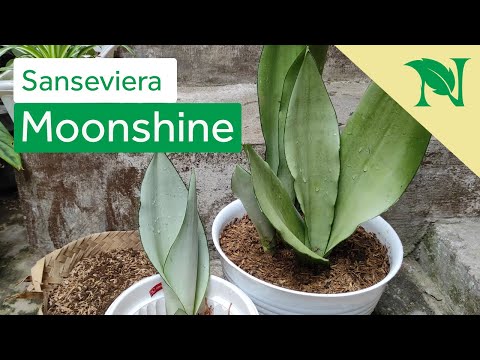Moonshine Sansevieria is a cultivated variety of Sansevieria trifasciata, which belongs to the family Asparagaceae.
As well as Sansevieria craigii, Sansevieria jacquinii, and Sansevieria laurentii superba, this amazing plant is also very popular as a houseplant.
This plant is commonly known as a snake plant in West Africa, for instance from Nigeria down to the Congo.
Another name that is used commonly is:
- Sansevieria Futura Silver Offset’
- Sansevieria trifasciata ‘Moonshine’
- Moonlight Sansevieria
- Silver Moonshine
- Moonshine snake plant
- Moonlight snake plant
A light, silver-green color can be seen on the leaves of these beautiful succulents.
Snake plant, or mother-in-law’s tongue, refers to the plant’s exceptionally sharp edges on its leaves.
Sansevieria Moonshine Care
Sansevieria Moonshine has broad silvery green leaves and is a beautiful snake plant. Moonshine can take low indirect light, but leaves tend to turn a darker shade of green in low light conditions. Moonshine tolerant of drought.
Size & Growth
The Sansevieria oohshine plant grows up to 2′ in height, which is larger than the Sansevieria trifasciata Hahnii.
Silver-green leaves with fine dark green lines longitudinally along their length give this cultivar its common name.
It is silvery-green in color, with dark green longitudinal lines running the length of the leaf.
When the leaves are in low lighting, their color may darken but still retain its silvery sheen.
These plants are vigorously growing.
Flowering and Fragrance
Although a cultivar may look somewhat like S. trifasciata bloom, it may not.
There isn’t a lot of bloom time and it occurs quite infrequently.
Although the flowers are white when they bloom, they are inconspicuous and slightly scented.
Light & Temperature
For Moonshine Sansevieria to grow indoors, indirect bright light (e.g. morning sun) is ideal.
Although the plant requires sunlight, it can also cope with low light conditions.
The plants are hardy to USDA Hardiness Zones 10 and 11, but thrive in temperatures as low as 55°F and as high as 85°F (13°C and 29° C).
When the temperature drops below 32 degrees Fahrenheit (0 degrees Celsius) Sansevieria moonshine is hardy.
Watering and Feeding
It is a succulent, so you don’t need much water for it to thrive and stay healthy.
The soil surface needs to have enough time to dry between waterings despite the fact that Sansevieria moonshine can withstand drought conditions.
Prevent root rot by keeping leaves dry and avoiding overwatering.
Once the temperatures start dipping low, lower watering frequency to once a month.
A general-purpose plant food should be applied to moonshine plants in the spring or summer twice a year.
Make sure not to overfeed the plants.
Soil & Transplanting
Mother-in-law’s tongue can be grown in standard succulent and cactus potting soil.
It is important that you choose the right soil because they are susceptible to root rot if water is left standing around the rhizome structure.
No matter what time of year you transplant the Moonshine plant, you shouldn’t bother rushing it.
Moonshine Sansevieria should be replanted every two to five years.
You must shake the root ball gently to remove it from the pot and then shake the root ball until it separates from the pot.
The new pot should be at least 1”-2” below the rim of the old one.
Grooming and Maintenance
If left on its own, this plant will thrive, but that doesn’t mean you should ignore it.
Moonshine Sansevieria plants require very little maintenance.
Care instructions are brief and easy to follow.
All you have to do to maintain your tree is remove any yellow or dead leaves that might be a sign of root rot.
One of the plants that is unique to Sansevieria is the spear plant – Sansevieria cylindrica.
How to Propagate Moonshine Sansevieria
As they have a strong, rapidly growing rhizome, Moonlight Sansevieria is best propagated by division.
One healthy leaf should be removed with the offset, while also removing new rhizome growth.
A mature leaf should have at least two inches long leaf cuttings.
Before transplanting, keep the cut areas dry and allow them to calluse before transplanting.
Divisions or offshoots should be planted in potting media with good drainage.
It is best to bury leaf cuttings a foot deep.
The leaf-cuttings should be soaked in water.
Cover the lead only a few inches deep with water in a tall container.
Remove the container from direct sunlight and place it in low light and keep the water fresh.
Moonshine Sansevieria Care – Pests or Diseases
Moonshine plant snake plants are hardy container plants that are usually resistant to serious disease or pest problems.
Neither mealybugs nor spider mites will bother your Sansevieria moonshine.
The good news is that these problems are relatively easy to deal with.
If the plant is exposed to too little light or the soil has too much moisture, it may be susceptible to scarring on the leaves.
There may also be a problem with the roots.
If you see things like yellowing or drooping leaves, keep an eye out for them.
Toxicity
Saponins are compounds found in Sansevieria species.
It is possible for humans and pets to be slightly toxic from these plant.
When swallowed, they could cause stomach discomfort or mouth irritation.
If consumed in large quantities, nausea and vomiting may occur.
Sansevieria Moonshine Uses
Potted indoors, these plants are ideal because of their upright growth. The upright growth allows them to grow in small light areas or locations with low lighting.
Consider using Sansevieria plants to frame succulents or ferns in the landscape.
Plant them directly in the ground or grow them in pots.
The thread of sansevieria moonshine, like other species, was once harvested to make bowstrings.
Indoors in cooler climates and outdoors in warmer climates, this plant is considered a houseplant.
______________________________________________________________________________________________________________________________
There are still many recent and interesting articles about Jade Plants..
..as well as other unique information from All Things Gardener..
For further information and other inquiries..
..you can contact us here


